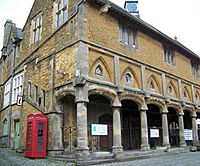Castle Cary and District Museum facts for kids

Market House
|
|
| Lua error in Module:Location_map at line 420: attempt to index field 'wikibase' (a nil value). | |
| Location | Castle Cary, Somerset, England, United Kingdom |
|---|---|
| Type | Local museum |
The Castle Cary and District Museum is a cool local museum in the town of Castle Cary, Somerset, England. It's a great place to learn about the history of the area.
The museum is located inside the historic Market House. This special building was built way back in 1855. It was designed by F.C. Penrose. People hoped it would bring more business to the town when the railway arrived. The Market House even has some parts from an older building that stood there since 1616. You can also see two old prison cells inside! It's also home to the local Information Centre.
Contents
What You Can See at the Museum
The museum has many different things to see. These exhibits are spread out over two floors. You can discover lots of interesting facts about Castle Cary and the surrounding area.
Ancient Fossils and Local Geology
One of the oldest things you can see are local fossils. These include spiral-shaped ammonites. There is also a display about a huge Ichthyosaurus skeleton. This ancient sea reptile was found nearby in Alford. You can also learn about the different types of rocks and land in the area.
Local History and Industries
The museum shows how people used to live and work here. You can learn about local industries like making rope and hemp. Companies like John Boyd Textiles and Donne & Sons were famous rope makers. They worked in the town from 1797 until the 1960s. There are also old farming tools and equipment. These show how people grew food and worked the land long ago.
The Story of Cary Castle
You can also find out about Cary Castle. This was a special type of castle called a motte and bailey castle. It was built after the Normans came to England. It might have been built by Walter of Douai or the Perceval family.
This castle was attacked twice by King Stephen. The first time was in 1138, and again in 1153. By 1468, people stopped using the castle. They built a manor house next to it instead. In 1890, people dug up the site. They found the foundations of a large square tower, about 24 meters (79 feet) wide.
The Diary of James Woodforde
One room in the museum is all about Parson James Woodforde. He was born in 1740 in nearby Ansford. He later worked as a church leader in Thurloxton. Then he moved to Norfolk. For almost 45 years, he wrote a diary. This diary is very special because it describes everyday life. It gives us a unique look into what life was like in rural England in the 1700s. He wrote about ordinary things, which helps us understand history better.

